Blog Archives
Beans: from garden to plate
Beans are a Kansas favorite in the vegetable garden. These warm-season plants are well acclimated to our tough Kansas summers. Once planted, they grow very fast and most varieties are ready to harvest in seven to eight weeks.

In the Demo Garden, beans are starting to produce. It is best to harvest when the pods are firm and crisp, but the bean seeds are not yet bulging. If at all possible, don’t pick them in the early morning when there is dew on the plants, as blight, a common bacterial disease, can easily be spread from one plant to another via splashing water droplets. So, make sure the plant foliage is dry before harvesting.
Green beans are typically grown for their immature pods. Beans such as navy and lima beans are allowed to fully ripen and then the bean seeds are removed from the pods; these types of beans are harvested much later in the season.

On April 28th, we planted four different varieties of bush style green beans (also called snap beans) in the Demo Garden: Heavy Harvest, Tenderette, Royal Burgundy, and Tendergreen Improved.
‘Heavy Harvest’ is a 53-day bean. This medium green-colored bean is also slender and grows about five inches long. So far, it is not living up to its namesake in that it has only yielded a small amount of beans so far.
‘Tenderette’ is a 58-day variety of bean. It also grows about five inches long and is slender. It is medium green in color. As with Heavy Harvest, this too only had a few ready to be picked.
‘Royal Burgundy’ is a 55-day variety that generally grows about five inches long. It is a slender bean with a deep purple coloring that is very beautiful and makes it very easy to see against the green foliage. Again, there were only a handful of beans to be found, but we are hopeful that with a little more time, they will start producing more.



‘Tendergreen Improved’ is a 52-day variety. The coloring, although still green, had a bit of a lighter, yellowish undertone compared to the other green beans. These beans are a little longer, growing up to six inches in length and is also plumper than the other varieties. The thing that is most impressive about Tendergreen so far is the yield. While it makes sense that there are more harvestable beans of this variety right now because its “days to maturity” (DTM) is shorter, this variety is still likely to out-produce the other varieties – but we will keep you updated!

So how do they cook up? Using a quick, identical technique on each variety, we tested them “tender-crisp” style. After the ends were trimmed, a ¼ cup water was added to a skillet along with the beans and cooked covered for three minutes. Then the cover was removed to allow the water to fully evaporate. A touch of butter was then added to each.
My personal favorite is the Tendergreen Improved. It was the most tender of the four varieties tested as well as the most prolific producer. Tenderette and Heavy Harvest where just slightly tougher than Tendergreen. Although the most unique to look at, the Royal Burgundy was the toughest of all the varieties, but interestingly, it turns from purple to green when cooked.

One final note: there was some significant stippling on the leaves of the beans, which is an indicator of spider mites. Spider mites are tiny, barely visible spider-relatives that suck juice from the underside of leaves and are common during hot, dry weather.

As a first defense against this garden pest, after harvesting the beans, we used the garden hose with a jet spray setting and shot the underside of the leaves with as much coverage as possible, and we plan to repeat this process a few times a week. Hopefully these pesky critters won’t ruin the harvest!

Click here to learn more about growing beans or spider mites.
By: Maureen Wilbeck, Master Gardener
Friday PhotoEssay – July 15, 2016
With another week of sun, rain, and heat, the garden continues to grow quickly. Many of our vines and other warm season vegetables are finally putting on some good growth. Surprisingly, the tomatoes are still looking really good with minimal signs of disease or other problems.
 Many of the plants have reached full-size, although the vining crops have yet to fill the trellises.
Many of the plants have reached full-size, although the vining crops have yet to fill the trellises.
 The Oriental Garden is really starting to look good. This ‘Ladyfinger’ okra didn’t germinate very well, but looking at the plants now, I’m glad that we only have 4 or 5 plants. They are starting to take over the surrounding area already! There are just a few buds starting to develop. Maybe by next week there will be some okra to show.
The Oriental Garden is really starting to look good. This ‘Ladyfinger’ okra didn’t germinate very well, but looking at the plants now, I’m glad that we only have 4 or 5 plants. They are starting to take over the surrounding area already! There are just a few buds starting to develop. Maybe by next week there will be some okra to show.

The ‘Goddess’ banana peppers are showing off this summer. We’ve grown banana peppers many times, but this variety is by far the most productive of the ones we’ve grown recently. The three plants have been loaded with peppers.
 The Pollinator garden is looking great with bright colors of the milkweeds, zinnias, and sages. This garden will just continue to grow, change, and get more beautiful as the summer progresses.
The Pollinator garden is looking great with bright colors of the milkweeds, zinnias, and sages. This garden will just continue to grow, change, and get more beautiful as the summer progresses.
 As I said earlier, the vines are just starting to take off. This is the Oriental garden. The left side of the trellises has beans and the luffa gourd. The right side of the trellises has cucmbers and melons. They are just starting to set fruit.
As I said earlier, the vines are just starting to take off. This is the Oriental garden. The left side of the trellises has beans and the luffa gourd. The right side of the trellises has cucmbers and melons. They are just starting to set fruit.
 Do you know what this is? It is the flower of a passionflower/passionfruit vine. I don’t know if it will actually produce fruit, but we are watching it grow and bloom in our Pollinator Garden. It is just starting to climb up the trellis.
Do you know what this is? It is the flower of a passionflower/passionfruit vine. I don’t know if it will actually produce fruit, but we are watching it grow and bloom in our Pollinator Garden. It is just starting to climb up the trellis.
Have a great weekend!
Friday PhotoEssay – June 17, 2016
Wow, it’s hot. I don’t know about your gardens, but in our garden the plants are definitely struggling to keep up with the heat. Because we had so much rain, many of them don’t have the developed root systems to deal with so much heat and evaporation. That said, our warm season veggies are starting to grow quickly.
One change that you can see is that we have mulched our peppers, tomatoes, and eggplant. We only had two bales, so the straw isn’t very thick and there are areas yet to be mulched. Straw mulch helps cool the soil and maintain even soil moisture. It helps prevent evaporation, which I’m all for during a hot spell like this!
 Most of our tomatoes have started to set fruit. This is ‘Tiren,’ a roma tomato. It has a really odd shape, which is kind of interesting. You can also see that one of them is starting to show signs of blossom end rot. This is very common on early season roma tomatoes in particular, but we’ve also had a little trouble with the drip system on the tomato garden. We will be watching to see if any of the other varieties also develop blossom end rot.
Most of our tomatoes have started to set fruit. This is ‘Tiren,’ a roma tomato. It has a really odd shape, which is kind of interesting. You can also see that one of them is starting to show signs of blossom end rot. This is very common on early season roma tomatoes in particular, but we’ve also had a little trouble with the drip system on the tomato garden. We will be watching to see if any of the other varieties also develop blossom end rot.
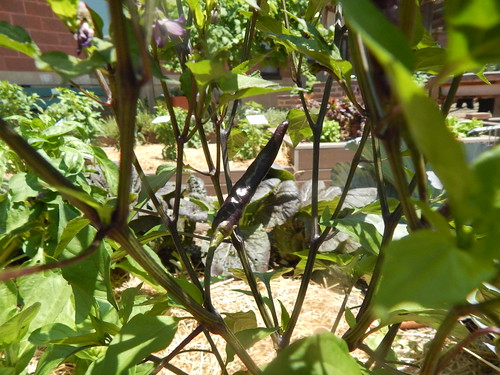 The purple cayenne pepper is also starting to set fruit. The flowers are purple, the stems are purple, and the peppers are purple. Eventually, the peppers will turn red when they reach the fully ripe stage.
The purple cayenne pepper is also starting to set fruit. The flowers are purple, the stems are purple, and the peppers are purple. Eventually, the peppers will turn red when they reach the fully ripe stage.
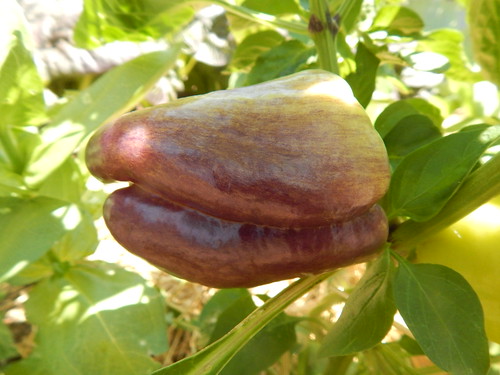 The ‘Islander’ bell pepper is also setting some fruit, and this one is getting large enough that it is developing some of the lavender coloration. This pepper will also turn red eventually, but it is purple at what would typically be the “green” stage for a bell pepper.
The ‘Islander’ bell pepper is also setting some fruit, and this one is getting large enough that it is developing some of the lavender coloration. This pepper will also turn red eventually, but it is purple at what would typically be the “green” stage for a bell pepper.
 The ‘Iznik’ snack cucumber is starting to flower a bit. It has fairly small fruit and a supposedly compact plant form, so we will be watching it for productivity and how much space it takes as it grows.
The ‘Iznik’ snack cucumber is starting to flower a bit. It has fairly small fruit and a supposedly compact plant form, so we will be watching it for productivity and how much space it takes as it grows.
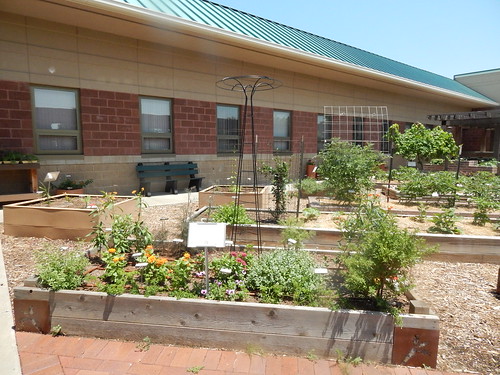 Last but not least…our semi-regular look-in at the pollinator garden. It isn’t filling in very rapidly, but we have some great flowering going on!
Last but not least…our semi-regular look-in at the pollinator garden. It isn’t filling in very rapidly, but we have some great flowering going on!
Have a great weekend!
Friday PhotoEssay – June 10, 2016
With a week of warm temperatures and no rain, everything is growing quickly. The end of the spring crops is almost here and the summer veggies are starting to set fruit!
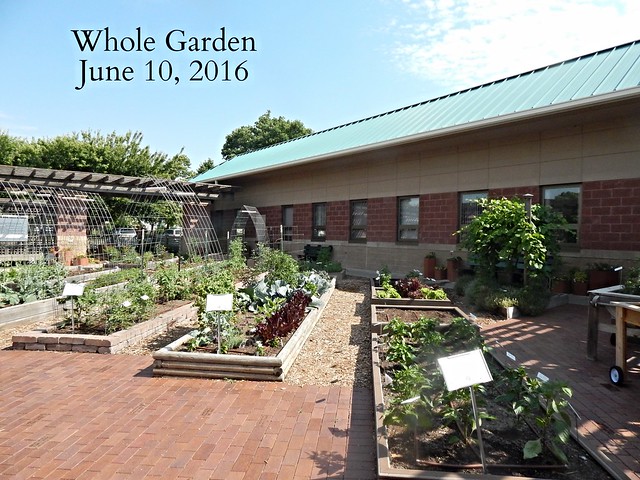 It’s hard to see from this overview photo, but I know that in a few weeks the tomatoes are going to be most of the way up the trellises and the garden will look completely different yet again. We did remove one of the quilt block lettuce gardens, since the lettuce was bolting. The other is holding on for a little longer.
It’s hard to see from this overview photo, but I know that in a few weeks the tomatoes are going to be most of the way up the trellises and the garden will look completely different yet again. We did remove one of the quilt block lettuce gardens, since the lettuce was bolting. The other is holding on for a little longer.
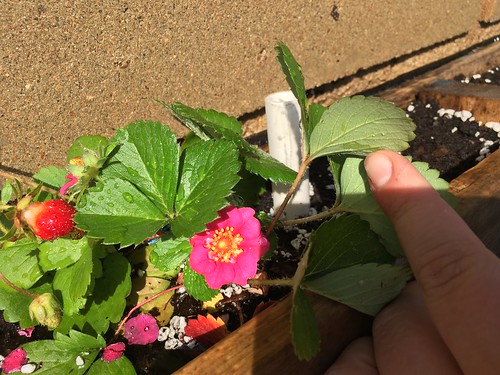 The ‘Rainbow Treasure’ strawberry on top of the pallet is blooming a bit and fruiting. The plant is still very small, but the colors are great.
The ‘Rainbow Treasure’ strawberry on top of the pallet is blooming a bit and fruiting. The plant is still very small, but the colors are great.
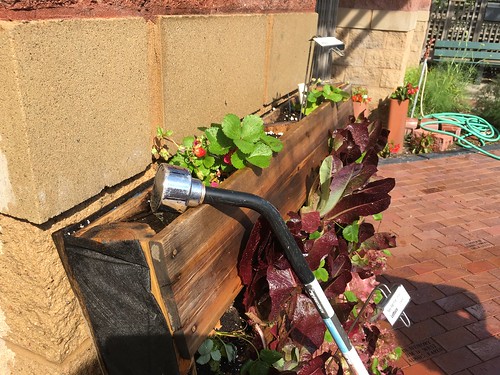 Let’s just say that watering the pallet garden is every bit as challenging as I expected it would be. We have the PVC tubes, but they don’t get the edges watered. We ended up putting the watering wand on the upper corner at a slow trickle to soak in. Still not ideal.
Let’s just say that watering the pallet garden is every bit as challenging as I expected it would be. We have the PVC tubes, but they don’t get the edges watered. We ended up putting the watering wand on the upper corner at a slow trickle to soak in. Still not ideal.
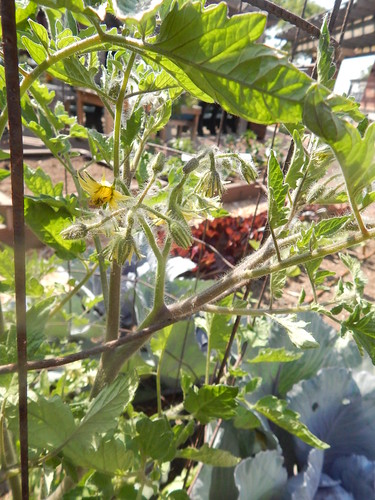 I keep trying and trying to capture a picture of the ‘Black Beauty’ tomato plant, because the stems have a purple cast to them that is striking and in contrast to the other plants. But with the sunlight, I can’t get it to show up the same way in a picture. You’ll have to come see it! As you can see, this plant (and most of the other tomatoes) are starting to bloom and set fruit.
I keep trying and trying to capture a picture of the ‘Black Beauty’ tomato plant, because the stems have a purple cast to them that is striking and in contrast to the other plants. But with the sunlight, I can’t get it to show up the same way in a picture. You’ll have to come see it! As you can see, this plant (and most of the other tomatoes) are starting to bloom and set fruit.
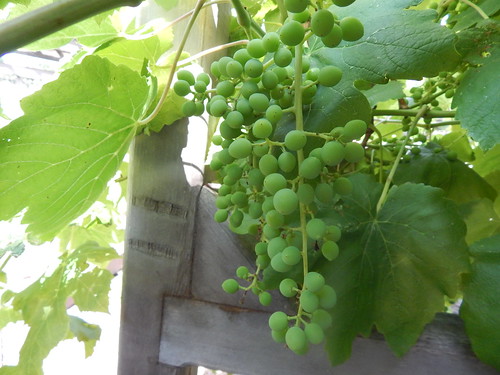 Our ‘Himrod’ grapevine is starting to fill out the fruit. It has quite few bunches this year, despite the vines not being overly large last year. Hopefully we don’t have any major insect or disease issues before harvest.
Our ‘Himrod’ grapevine is starting to fill out the fruit. It has quite few bunches this year, despite the vines not being overly large last year. Hopefully we don’t have any major insect or disease issues before harvest.
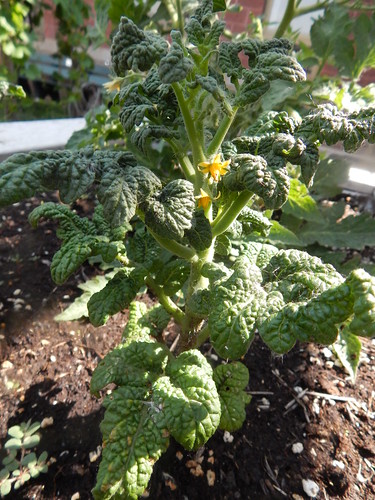 This is the ‘Patio Plum’ toamto plant. It is maybe 8 inches tall, but showing tiny flowers. I keep wanting to think there is something wrong with it, but it seems perfectly healthy. Just super tiny!
This is the ‘Patio Plum’ toamto plant. It is maybe 8 inches tall, but showing tiny flowers. I keep wanting to think there is something wrong with it, but it seems perfectly healthy. Just super tiny!
Have a great weekend!
Friday PhotoEssay – June 3, 2016
It seems as though the recent rainy spell has come to an end, and we had a lot of catch up to do in the garden this week.
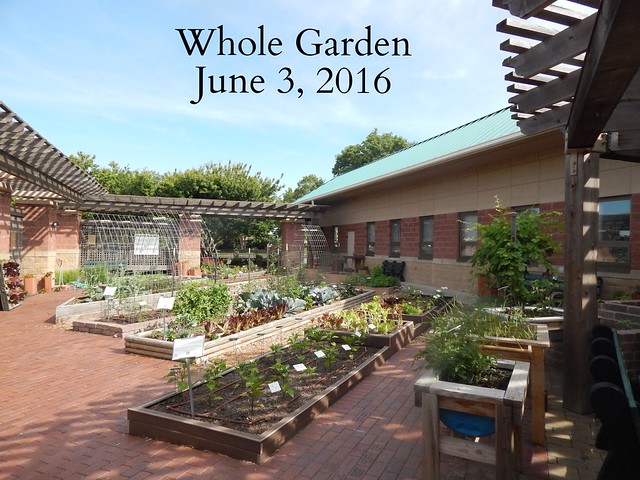 The tomatoes, lettuce, cabbage, and peas have been growing well despite the rain and cool temperatures. The peppers and eggplant are languishing a bit, and some of the vine crops haven’t come up well.
The tomatoes, lettuce, cabbage, and peas have been growing well despite the rain and cool temperatures. The peppers and eggplant are languishing a bit, and some of the vine crops haven’t come up well.
 Despite the fact that it hasn’t been that warm, some of the lettuces have still started bolting, particularly the oakleaf varieties. We harvested heavily yesterday, leaving these “lettuce trees” behind. Normally the main lettuce stem stays squat and near the ground. These are bolting (going to seed) and so the stem has lengthened out to put on the flower stalk. We will probably remove the lettuce from this bed next week. The lettuce in the other quilt block is more heat tolerant and isn’t bolting yet.
Despite the fact that it hasn’t been that warm, some of the lettuces have still started bolting, particularly the oakleaf varieties. We harvested heavily yesterday, leaving these “lettuce trees” behind. Normally the main lettuce stem stays squat and near the ground. These are bolting (going to seed) and so the stem has lengthened out to put on the flower stalk. We will probably remove the lettuce from this bed next week. The lettuce in the other quilt block is more heat tolerant and isn’t bolting yet.
 When we planted the Black Scorzonera seeds, we were a little bit concerned because it was supposed to take up to three weeks to germinate and the soil needed to be kept moist. Thankfully, the soil staying moist wasn’t an issue at all! We also had very quick and high germination. I’m excited to see how these do.
When we planted the Black Scorzonera seeds, we were a little bit concerned because it was supposed to take up to three weeks to germinate and the soil needed to be kept moist. Thankfully, the soil staying moist wasn’t an issue at all! We also had very quick and high germination. I’m excited to see how these do.
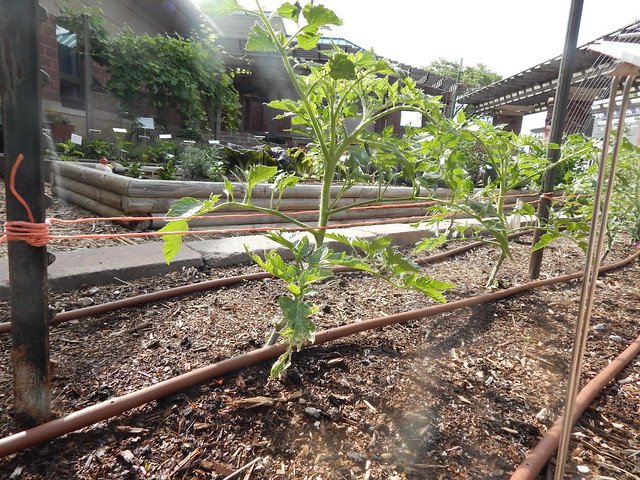 The tomatoes took advantage of the weather to get a little bit taller than I might have preferred before the first tie on the stake & weave. We did that yesterday. We also removed the lower suckers from the plants. If you’ve never seen a stake & weave system in person, come out and take a look over the next few weeks as the plants grow.
The tomatoes took advantage of the weather to get a little bit taller than I might have preferred before the first tie on the stake & weave. We did that yesterday. We also removed the lower suckers from the plants. If you’ve never seen a stake & weave system in person, come out and take a look over the next few weeks as the plants grow.
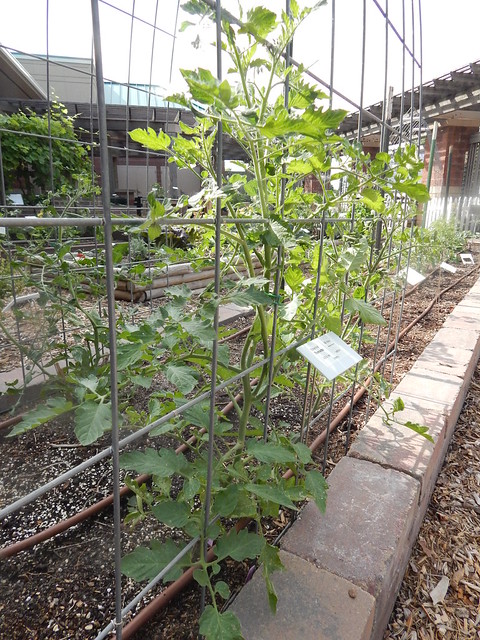 The tomatoes on the cattle panel trellis have also been growing well. We removed the larger suckers on these as well and used plant clips to attach them to the trellis.
The tomatoes on the cattle panel trellis have also been growing well. We removed the larger suckers on these as well and used plant clips to attach them to the trellis.
 We harvested a bunch of the purple kohlrabi this week, leaving just a few of the smaller ones for another time. They have done very well!
We harvested a bunch of the purple kohlrabi this week, leaving just a few of the smaller ones for another time. They have done very well!
 The K-State Purple garden is really showing off right now…we also harvested a nice amount of purple snow peas from the trellis.
The K-State Purple garden is really showing off right now…we also harvested a nice amount of purple snow peas from the trellis.
Last but not least, a quick check-in with our Pollinator garden. It’s doing well, although hasn’t filled in much with the cool weather.
Have a great weekend!






